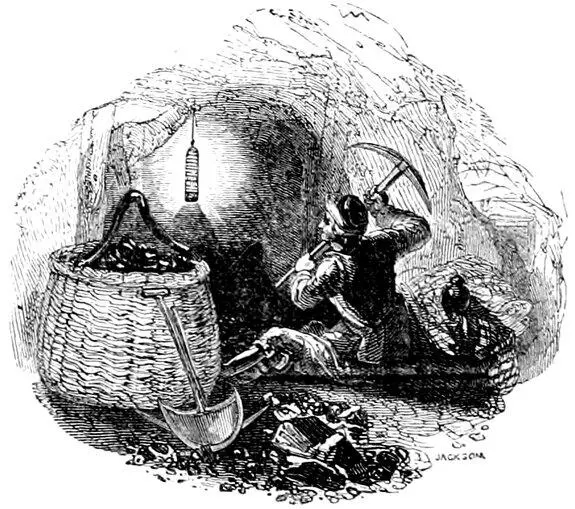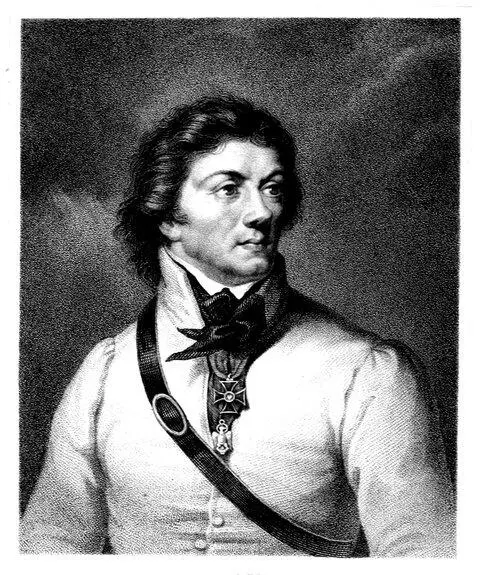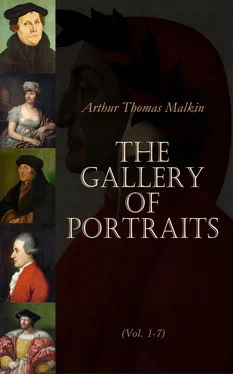The winter of 1828–9 he spent at Rome; with returning spring he expressed a wish to visit Geneva, but his hours were numbered. He reached that city on May 28, unusually cheerful; dined heartily on fish, and desired to be daily supplied with every variety which the lake afforded: a trifling circumstance, yet interesting from its connection with his love of sport. In the course of the night he was seized with a fresh attack, and expired early in the morning without a struggle. His remains were honoured by the magistrates with a public funeral, and repose in the cemetery of Plain Palais. He died without issue, and the baronetcy is in consequence extinct.


Engraved by W. Holl. KOSCIUSZKO. From a Print engraved in 1829 by A. Pleszczynski, a Pole. Under the Superintendance of the Society for the Diffusion of Useful Knowledge. London. Published by Charles Knight, Pall Mall East.

Table of Contents
Among the remarkable men of modern times, there is perhaps none, whose fame is purer from reproach, than that of Thaddeus Kosciusko. His name is enshrined in the ruins of his unhappy country, which, with heroic bravery and devotion, he sought to defend against foreign oppression, and foreign domination. Kosciusko was born at Warsaw, about the year 1755. He was educated at the school of Cadets, in that city, where he distinguished himself so much in scientific studies as well as in drawing, that he was selected as one of four students of that institution, who were sent to travel at the expense of the state, with a view of perfecting their talents. In this capacity he visited France, where he remained for several years, devoting himself to studies of various kinds. On his return to his own country he entered the army, and obtained the command of a company. But he was soon obliged to expatriate himself again, in order to fly from a violent but unrequited passion, for the daughter of the Marshal of Lithuania, one of the first officers of state of the Polish court.
He bent his step to that part of North America, which was then waging its war of independence against England. Here he entered the army, and served with distinction, as one of the adjutants of General Washington. While thus employed, he became acquainted with La Fayette, Lameth, and other distinguished Frenchmen, serving in the same cause; and was honoured by receiving the most flattering praises from Franklin, as well as the public thanks of the Congress of the United Provinces. He was also decorated with the new American order of Cincinnatus, being the only European, except La Fayette, to whom it was given.
At the termination of the war he returned to his own country, where he lived in retirement till the year 1789, at which period he was promoted by the Diet to the rank of Major-General. That body was at this time endeavouring to place its military force upon a respectable footing, in the vain hope of restraining and diminishing the domineering influence of foreign powers, in what still remained of Poland. It also occupied itself in changing the vicious constitution of that unfortunate and ill-governed country—in rendering the monarchy hereditary—in declaring universal toleration—and in preserving the privileges of the nobility, while at the same time it ameliorated the condition of the lower orders. In all these improvements, Stanislas Poniatowski, the reigning king, readily concurred; though the avowed intention of the Diet was, to render the crown hereditary in the Saxon family. The King of Prussia (Frederic William II.), who, from the time of the Treaty of Cherson in 1787, between Russia and Austria, had become hostile to the former power, also encouraged the Poles in their proceedings; and even gave them the most positive assurances of assisting them, in case the changes they were effecting occasioned any attacks from other sovereigns.
Russia at length, having made peace with the Turks, prepared to throw her sword into the scale. A formidable opposition to the measures of the Diet had arisen, even among the Poles themselves, and occasioned what was called the confederation of Targowicz, to which the Empress of Russia promised her assistance. The feeble Stanislas, who had proclaimed the new constitution, in 1791, bound himself in 1792 to sanction the Diet of Grodno, which restored the ancient constitution, with all its vices and all its abuses. In the meanwhile, Frederic William, King of Prussia, who had so mainly contributed to excite the Poles to their enterprises, basely deserted them, and refused to give them any assistance. On the contrary, he stood aloof from the contest, waiting for that share of the spoil, which the haughty Empress of the north might think proper to allot to him, as the reward of his non-interference.
But though thus betrayed on all sides, the Poles were not disposed to submit without a struggle. They flew to arms, and found in the nephew of their king, the Prince Joseph Poniatowski, a general worthy to conduct so glorious a cause. Under his command Kosciusko first became known in European warfare. He distinguished himself in the battle of Zielenec, and still more in that of Dubienska, which took place on the 18th of June, 1792. Upon this latter occasion, he defended for six hours, with only four thousand men, against fifteen thousand Russians, a post which had been slightly fortified in twenty-four hours, and at last retired with inconsiderable loss.
But the contest was too unequal to last; the patriots were overwhelmed by enemies from without, and betrayed by traitors within, at the head of whom was their own sovereign. The Russians took possession of the country, and proceeded to appropriate those portions of Lithuania and Volhynia, which suited their convenience; while Prussia, the friendly Prussia, invaded another part of the kingdom.
Under these circumstances, the most distinguished officers in the Polish army retired from the service, and of this number was Kosciusko. Miserable at the fate of his unhappy country, and at the same time an object of suspicion to the ruling powers, he left his native land, and retired to Leipsic; where he received intelligence of the honour which had been conferred upon him by the Legislative Assembly of France, who had invested him with the quality of a French citizen.
But his fellow-countrymen were still anxious to make another struggle for independence; and they unanimously selected Kosciusko as their chief and generalissimo. He obeyed the call, and found the patriots eager to combat under his orders. Even the noble Joseph Poniatowski, who had previously commanded in chief, returned from France, whither he had retired, and received from the hands of Kosciusko the charge of a portion of his army.
The patriots had risen in the north of Poland, to which part Kosciusko first directed his steps. Anxious to begin his campaign with an action of vigour, he marched rapidly towards Cracow, which town he entered triumphantly on the 24th of March, 1794. He forthwith published a manifesto against the Russians; and then, at the head of only five thousand men, he marched to meet their army. He encountered, on the 4th of April, ten thousand Russians at a place called Wraclawic; and entirely defeated them, after a combat of four hours. He returned in triumph to Cracow, and shortly afterwards marched along the left bank of the Vistula to Polaniec, where he established his head quarters.
Читать дальше















